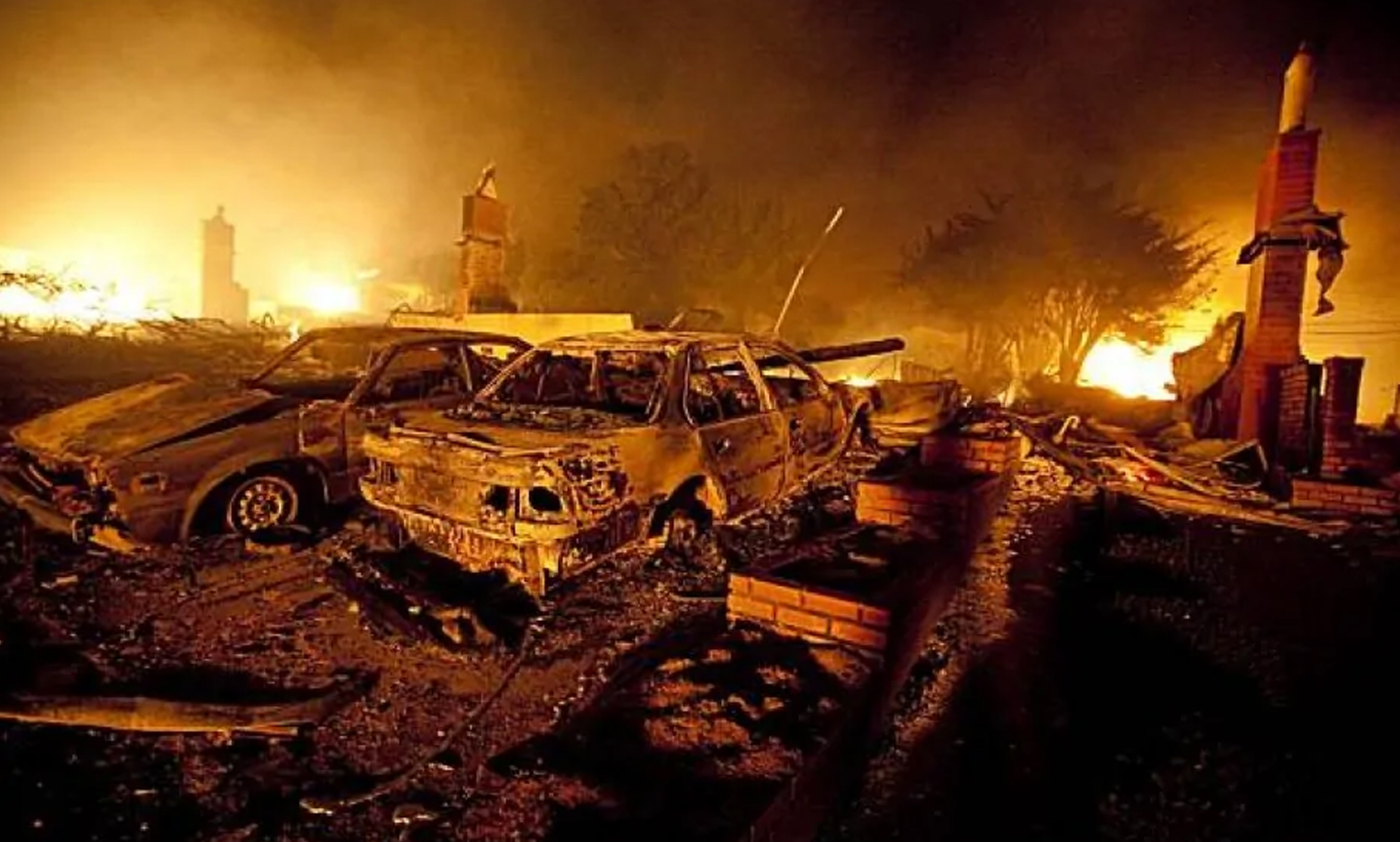On September 9, 2010 a 30–inch diameter natural gas pipeline owned by Pacific Gas and Electric (PG&E) exploded in a quiet neighborhood in San Bruno, California, killing eight people and destroying 38 homes.
The event has changed the lives of many people, and has also shaped the way many of us think about how spatial information is managed in utilities. As with any tragedy, the San Bruno pipeline explosion offers an opportunity for us to look at what happened so we can learn and hopefully never have to experience an issue like this in our lifetimes. This article will focus on the geospatial information management aspects of San Bruno.
Photo by Eric Risberg
Author’s note: While I have worked with many utility companies in my career, I have not had any direct involvement with the GIS activities at Pacific Gas and Electric. This article is based on research I have done based on publicly available information. As part of my professional development I annually devote a portion of my time to studying professional ethics issues in my field. I am sharing this because the San Bruno utility incident is something we can all learn from.
San Bruno explosion background
On February 14, 2011 the San Francisco Chronicle published an article on the PG&E geographic information system and the challenges the utility has had over the last 20 years as they sought to deal with challenges with their GIS mapping. For those of us who have spent major parts of our careers working with GIS some of the challenges may sound familiar.
At the heart of the problem was a faulty pipe. PG&E researchers believe that 30” pipe supplies were running low back when the line was constructed in 1956 and surplus, or potentially salvaged pipe was used to fabricate the failed segment. Over time the records of the segments and the details of welds were somehow lost. When PG&E built their GIS in the 1990s this information was not included in the GIS. During hearings on the case a PG&E engineer testified that issues about data quality had been raised for many years and that gaps in the data were commonly known.
An earlier article from the Chronicle also highlighted issues with missing map sheets from the PG&E gas distribution system. The paper reported that there were 16 map sheets that were lost for up to two decades. The sheets were normally used to support mandated piping inspections and the system had not been inspected for many, many years. When the issues with the missing sheets were uncovered PG&E hurriedly initiated inspections on the 14 miles of previously missing pipe and found 22 leaks, including one that was considered an immediate danger.
Perhaps the most damning issue however was a management practice that seems to have encouraged employees not to find issues with the pipeline system. Like most gas utilities, PG&E has used leak surveys to support their required inspection processes and to determine the ultimate safety of their lines. Between 2004 and 2008 the company had instituted an incentive policy that rewarded crews that found fewer leaks in the pipeline system. An audit revealed that the tests performed under these incentives were not effective. When new tests were run 38 high-priority gas leaks were found, including four leaks that required reporting to federal officials.
From a regulatory relations standpoint things got even worse this summer when PG&E officials were caught seeking to influence the California Public Utilities Commission to select a state judge that would rule favorably in an upcoming rate request. The actions resulted in the dismissal of employees from both PG&E and the CPUC. An investigation is currently underway and PG&E has formally announced that they participated in improper communications with the Commission.
Photo by Brant Ward, The Chronicle
So what does Geographic Information Systems (GIS) have to do with it?
GIS has been featured in a number of the articles associated with PG&E and the San Bruno explosion. Is GIS mapping the problem? Could it have prevented the tragedy? The answer is “probably not” for both of those questions. Here’s why:
GIS data is not necessarily as comprehensive as the San Francisco Chronicle article implies. Most GIS maps are fairly general. They show pipelines, locations, fittings, valves, land features, and much more information, all geographically positioned on the earth. Anyone who has been more closely involved in the utility construction process knows however that GIS maps do not contain nearly as much information as exists in the original construction drawings. And the construction drawings do not contain all the details either. The information about welds and detailed construction are often contained in fabricators’ details, sometimes referred to as “shop drawings.” In fact, GIS maps are typically simplified from the construction drawings so they can be easier to read when used to support field operations.
A well-implemented GIS can certainly help. GIS can form a reference to other sources of related information. Construction drawings, work orders, and other details including inspection records can be linked to GIS mapping records so they can be easily referenced when engineers and operators seek to gather more information to assess the conditions of the pipelines they are managing.
A well-implemented GIS is also an integrated GIS. The information described above is often best hosted in a document management system and linked to the GIS records. The inspection processes that were suspected at PG&E are typically managed by an asset management system (AMS). The GIS can be integrated with the AMS to provide a geographic context to support the inspection work processes along with the appropriate details of the assets to be inspected.
What Can Utility GIS Professionals learn from the San Bruno utility explosion?
Going back to the original question posed in this article, there is much we can learn.
Data matters!
From the top down, progressive utility organizations are realizing the importance of managing their information so that they can make the best decisions. The value of the gas assets managed by the PG&E GIS is in excess of $14 billion. Going beyond the obvious safety considerations, the details of any multi-billion dollar asset portfolio can have a huge impact on return on investment. PG&E has spent nearly $2.5 billion on non-recoverable charges related to gas matters since the PG&E San Bruno explosion, which is a very large percentage of the portfolio value. Taking this perspective on the management of GIS data might be helpful to those utilities that need help in justifying additional investment in their GIS data management.
Systems are as good as the people who manage them.
As a GIS consultant for the utility industry, I have seen some very strong GIS systems, and some very weak ones. The differences have rarely been caused by the core GIS platform in use. Yes, some systems do things better than others, but the difference is nearly always the people. People that generate outstanding results usually have strong management that is effective in setting meaningful goals and infusing a passion for accomplishing the work at hand.
It is incumbent on all of us as managers and leaders (and we can manage and lead from any position in our organizations) to translate the complexity of advanced systems into meaningful objectives that make sense and motivate all the people around us to do great things.
Be careful of how you incentivize your people.
Doing more things at a faster rate may not always be better. The experiences with the PG&E gas inspection incentives appear to have driven negative behavior that exposed the utility to the potential to have serious safety and compliance issues. The PG&E management team made some mistakes with San Bruno utilities, but they also noticed the problem and changed things to mitigate the problems they were creating. What behaviors are you exhibiting with your teams that improve short-term productivity at the expense of overall quality, and possibly life safety? Incentives can be amazingly effective, or very dangerous, depending on how they are implemented.
Strive for continuous improvement.
Put actionable plans in place to make your GIS better every year. These systems are dynamic and will rapidly lose value if they are not enriched on a regular basis. The large volumes of spatial information that are generated each year continue to increase at a rapid rate. Meanwhile, regulations are getting stricter and information is becoming more important. The world’s infrastructure is getting older and more vulnerable. All these factors are opportunities to do more with spatial technologies.
Photo by Jana Asenbrennerova, Special to the San Francisco Chronicle
GIS Conclusions from the San Bruno Utility Explosion
PG&E was fined $1.4 billion for their role in the San Bruno explosion. This, added to the nearly $2.5 billion spent on non-recoverable charges related to gas matters since the incident, add up to nearly $4 billion in expenses that could have been avoided. None of this, however, adds up to the human impact of this crisis. I’m hopeful that this article will stimulate some thoughts on how we as professionals can contribute to improvements in managing the spatial information used by utilities.
How Spatial Business Systems Utility Solutions can help the utility design industry
Spatial Business Systems helps utility companies provide safe, efficient, and cost-effective software and services to its customers. Its software and service solutions support Geographical Information Systems, maximizing the benefit received from GIS. An integrated GIS provides accurate spatial information and a more comprehensive geographic context. Because of Spatial Business Systems’ years of experience consulting and designing solutions for utility companies, we know which software integrations, plug-ins, and data management systems can save designers hundreds of hours and your organization thousands of dollars.
Spatial Business Systems provides data management and integrated design solutions, including Automated Utility Design™, Substation Design Suite, and Utility DataHub, to organizations that depend on spatial information. We leverage our technical skills and innovative software to assist the day-to-day operations and advanced analytics of utility organizations. Learn more about our integrated design solutions here. We also provide a full suite of data management solutions including consulting services to implement Spatial MDM solutions and FME software. We have Certified FME trainers on staff ready to help your organization. Learn more about Spatially Enabled Master Data Management here. Interested in implementing our solutions or learning more about SBS? Send us a message.
Please speak up!
I’d enjoy hearing your thoughts on how utilities can improve the safe operations of their systems through the proper use of GIS. Please share your thoughts with us.
References
Wiki:
http://en.wikipedia.org/wiki/2010_San_Bruno_pipeline_explosion
PUC / Legal Issues:
PG&E to be penalized $1.4 billion for San Bruno explosion
http://www.mercurynews.com/business/ci_26453077/pg-e-be-fined-1-4-billion-san
September 2, 2014
Attorney General Kamala Harris Called On To Investigate Secret PG&E-CPUC Emails
http://sanfrancisco.cbslocal.com/2014/09/19/attorney-general-kamala-harris-called-on-to-investigate-secret-pge-cpuc-emails-san-mateo-san-bruno-pipeline-explosion/
September 19, 2014
State Senator Says PG&E Trying To Get Away With Murder; Emails Following Deadly 2010 San Bruno Explosion Examined
http://sanfrancisco.cbslocal.com/2014/07/28/state-senator-says-pge-trying-to-get-away-with-murder-emails-following-deadly-2010-san-bruno-explosion-examined/
July 28, 2014
Senior PG&E, CPUC Officials Lose Jobs Over Improper Email Communications
http://sanfrancisco.cbslocal.com/2014/09/15/pge-officials-removed-for-communications-with-california-regulators/
September 15, 2014
PG&E TAKES ACTION TO ADDRESS EX PARTE COMMUNICATION ISSUES
http://www.pge.com/about/newsroom/newsreleases/20140915/pge_takes_action_to_address_ex_parte_communication_issues_identified_in_self-report_to_cpuc_today__pledges_no_excuses_compliance.shtml
September 15, 2014
PACIFIC GAS AND ELECTRIC COMPANY’S NOTICE OF IMPROPER EX PARTE COMMUNICATIONS
http://www.pgecorp.com/di3fid/PGE_Notice.pdf
September 15, 2014
GIS / Information Management Related Topics
PG&E Ignored Gaps in Data, Engineer Says
http://www.sfgate.com/news/article/PG-E-ignored-gaps-in-data-engineer-says-3752181.php
July 31, 2012
PG&E’s computers faulted: Utility’s pipeline data full of omissions, errors
http://www.montereyherald.com/state/ci_17383410?nclick_check=1
February 14, 2011
History of Deadly Gas Pipeline Revealed
//www.baycitizen.org/news/san-bruno-explosion/history-deadly-gas-pipeline-revealed/
March 1, 2011
PG&E incentive system blamed for leak oversights
http://www.sfgate.com/news/article/PG-E-incentive-system-blamed-for-leak-oversights-2424430.php
December 25, 2011
Missing maps mean PG&E lines weren’t inspected
http://www.sfgate.com/default/article/Missing-maps-mean-PG-E-lines-weren-t-inspected-2433856.php
December 31, 2011
Post-Disaster, PG&E Turns to Tech
http://blogs.wsj.com/cio/2013/03/29/post-disaster-pge-turns-to-tech/
March 29, 2013
All Points Blog:
PG&E Will Share Shutoff Valve Locations with Public Safety Agencies
http://apb.directionsmag.com/entry/pge-will-share-shutoff-valve-locations-with-public-safety-agencies/162775
Oct 6, 2010
PG&E GIS Examined as Part of Explanation of San Bruno Gas Pipe Explosion
http://apb.directionsmag.com/entry/pge-gis-examined-as-part-of-explanation-of-san-bruno-gas-pipe-explosion/164576
February 15, 2011
PG&E’s GIS implementation faulted in San Bruno Explosion
http://egis3.lacounty.gov/eGIS/2011/02/17/pges-gis-implementation-faulted-in-san-bruno-explosion/
February 17, 2011 (references San Francisco Chronicle article).
PG&E Loses Maps, Fails to Leak Test 14 Miles of Pipeline for Up to 20 Years
http://apb.directionsmag.com/entry/pge-loses-maps-fails-to-leak-test-14-miles-of-pipeline-for-up-to-20-ye/223320
January 3, 2012







